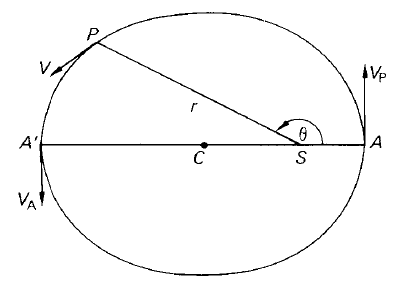
The energy integral
 المؤلف:
A. Roy, D. Clarke
المؤلف:
A. Roy, D. Clarke
 المصدر:
Astronomy - Principles and Practice 4th ed
المصدر:
Astronomy - Principles and Practice 4th ed
 الجزء والصفحة:
p 176
الجزء والصفحة:
p 176
 11-8-2020
11-8-2020
 2207
2207
The energy integral
If we multiply equation (1)
 (1)
(1)
by dx/dt and (2)
 (2)
(2)
by dy/dt and add, we obtain the relation
 (3)
(3)
Now

Also, r 2 = x2 + y2 so that


Figure 1. The velocity of a planet in an elliptical orbit showing that at perihelion A and aphelion A' the velocity vector is perpendicular to the radius vector.
giving

Hence, equation (3) may be written as a perfect differential, namely

Integrating, we obtain
 (4)
(4)
where C is the so-called energy constant and V is the velocity of one mass with respect to the other since

The first term, 1/2 V 2, is the kinetic energy, energy the planet in its orbit about the Sun possesses by virtue of its speed. The second term, −μ/r, is the potential energy, energy the planet possesses by
virtue of its distance from the Sun.
What equation (4) states is that the sum of these two energies is a constant, a reasonable statement since the two-body is an isolated system, no energy being injected into the system or being removed from it. In an elliptic orbit, however, the distance r is changing. Equation (4) shows that there is a continual trade-off between the two energies: when one is increasing, the other is decreasing. If we wish to obtain an expression giving the velocity V of the planet, we must interpret the constant C. This is done in the following section.
 الاكثر قراءة في مواضيع عامة في علم الفلك
الاكثر قراءة في مواضيع عامة في علم الفلك
 اخر الاخبار
اخر الاخبار
اخبار العتبة العباسية المقدسة


